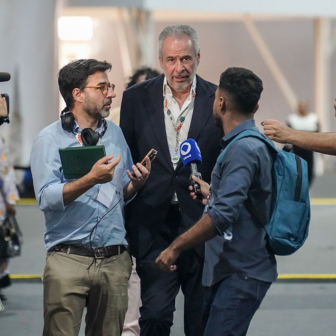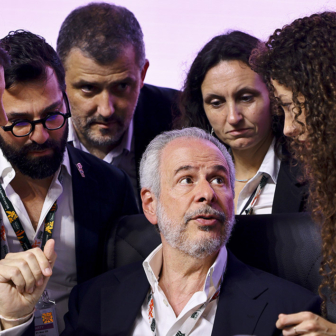PUT UP YOUR HAND if you understand how emissions trading works. Leave it up if you think the Rudd government’s Carbon Pollution Reduction Scheme (CPRS to its friends) is the best possible way of tackling climate change. Now that everyone has their hands comfortably by their sides, let’s consider the most poorly understood, and most bizarre, feature of the CPRS – namely that, when the CPRS is introduced, individual efforts to reduce emissions will have absolutely no impact on the total level of emissions in Australia.
Let’s be clear about this. When the CPRS comes in, it won’t matter how many solar hot water systems are installed, how many airconditioners sit unused on a summer’s day or how small our cars are. Unless the CPRS is either amended or defeated in the Senate, it will be impossible for individuals to reduce Australia’s emissions below the five per cent target decreed by the government.
It works like this. The first step is that each year the federal government will issue a fixed number of carbon pollution permits. Most will be given to the big polluters and some will be auctioned. It will be illegal for big polluters to generate more emissions than the number of tonnes allowed by the permits they hold.
The second step is where the “trading” in emissions trading comes in. If a big polluter wants to increase the amount of pollution it releases it can do so, but only if it can buy a permit from one of the other big polluters. While the total number of permits issued by the government will mandate a decline of five per cent in the Australia-wide level of pollution by 2020, there will be no need for any individual polluter to reduce emissions. In fact, a polluter can go on increasing its emissions as long as it can find another polluter willing to sell it permits.
This is where the problems begin. Under the proposed scheme, if individuals, communities or state governments try to do their bit for the environment, all they will achieve is the freeing up of permits for the big polluters to increase their emissions. Fewer emissions from an individual mean more emissions from an aluminium smelter. Fewer emissions from one state simply mean more emissions from another state.
Consider this example. If the NSW government makes its schools and hospitals more energy efficient, they will need to purchase less electricity. The coal-fired power stations that supply their power will burn a bit less coal and, as a result, will produce fewer emissions. Now that the power station has lowered its emissions, it will need fewer permits, freeing up “spare” permits that it can then sell to the aluminium industry or any other large polluter.
Unfortunately, the same system applies for households and community groups. If a household installs solar panels on the roof, under the government’s emissions trading scheme the investment will not reduce Australia’s emissions by a single kilogram. Lower household demand for electricity will simply free up extra permits for big polluters to expand their pollution.
The fundamental design flaw in the proposed CPRS has occurred because organisations issued with permits (the big polluters) will continue to own any spare permits that result from emissions reductions, even if those reductions are the result of efficiency gains made by individuals, local governments or state governments. Worse still, the big polluters will be able to profit from selling the “spare” permits.
It can’t be that bad, I hear you say. No one would deliberately invent a system that actually prevents households, communities, local governments and state governments from doing their bit to tackle climate change. Unfortunately, although the operation of emissions trading is poorly understood by the public, governments around the country understand it all too well. For example, in the words of the NSW government’s Independent Pricing and Regulatory Tribunal:
“Under an emissions trading scheme, the quantum of allowable emissions will be fixed. The limit on emissions will apply to all emissions sources covered by the scheme. Additional measures to reduce emissions in sectors covered by the scheme would not result in an increase in emissions abatement – under the global cap, the emissions avoided through undertaking an additional measure would result in an equivalent increase in emissions elsewhere. How and/or where emissions are reduced changes, not the amount.”
The office of the climate change minister, Penny Wong, is a little more obtuse in dealing with queries about this issue. When faced with the simple question: “Once the CPRS comes in will putting a solar panel on my roof reduce Australia’s emissions by an extra kilogram?” her office likes to point out that:
a. investing in energy efficiency can help households save money,
b. using less energy helps to lower households’ carbon footprint,
c. the government thinks that everyone should pull together to tackle climate change.
All true, but irrelevant. What they don’t say is:
d. No, under the CPRS the level of emissions is fixed by the federal government when it chooses how many permits to hand out. Once the scheme comes into operation, all that individuals can do is alter the percentage of emissions that come from the household sector and the percentage of emissions generated by the big polluters. On behalf of the big polluters, the Rudd government would like to urge households to do everything they can to reduce their own emissions. It won’t help the environment, but it will make life much easier for the biggest emitters.
The saddest part of this whole problem is that the system need not be so absurd. It is possible to amend the scheme so that those who invest in energy efficiency are given the “spare” permits they have created. If these permits are then retired rather than sold to other polluters, the result would be a genuine reduction in Australia’s emissions. It’s not surprising that the big polluters don’t think this problem is worth solving but it is surprising that so soon after ratifying the Kyoto Protocol the PM is not only happy to introduce unambitious targets but also to ensure that anyone who wants to go further is prevented from doing so.
Without asking, the Commonwealth is proposing to take over all responsibility for tackling climate chang, not just from individuals but from local councils and even state governments. To date, the states have been silent on this takeover. Not one state premier or environment minister has stood up and told their electorates that once the CPRS comes in their states will be entirely impotent in the fight against climate change. Given their previous rhetoric, this silence is surprising.
The ACT government, for example, has announced its intention to implement “tougher targets” than those sought by Penny Wong and is holding an inquiry into what those targets should be. The Victorian government has a target of reducing household emissions by 10 per cent by 2010. The South Australian government has set a renewable energy target of 20 per cent by 2014. Not one state leader has come out to defend the right of the states to set such targets or to demand changes to the CPRS to make sure that the targets they set lead to an actual reduction in Australia’s emissions.
The Rudd government disappointed many people when it announced its intention to set an emissions reduction target of only five per cent by 2020. But many of those people incorrectly assumed that they and their communities could go where the federal government fears to tread. The most alarming thing about the CPRS is not its pathetic targets – it’s the way that it locks us into failure. The CPRS will legislate away the ability for individuals, local governments and state governments to go further than the Rudd government has decreed.
The unfortunate reality is that, having waited a decade for a government to express a willingness to do something about climate change, we are now faced with a choice between two options: either sticking with a policy that locks us into failure by dictating that emissions cannot fall by more than five per cent or abandoning the CPRS altogether. If the federal government refuses to make substantial changes to its scheme, the latter appears more appealing.
What could we do instead? The simplest thing to do in the short term is to introduce a carbon tax of around $25 per tonne. As luck would have it, the administrative infrastructure the government needs to run the CPRS is almost identical to that required for a carbon tax. If we can iron out the problems with the CPRS and establish decent targets, we can always move towards a CPRS down the track. •




